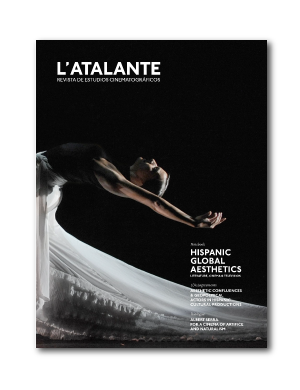Published 2018-07-31
Keywords
- Festival film,
- Aesthetics,
- Disaffection,
- Detachment,
- Novísimos
- Minimalism,
- Transnationalism. ...More
How to Cite
Copyright (c) 2018 L'Atalante. Journal of film studies

This work is licensed under a Creative Commons Attribution-NonCommercial-NoDerivatives 4.0 International License.
Abstract
The increasingly transnational character of contemporary Latin American cinema has led to the emergence of new analytical categories for its study. This article centers on the so-called festival film and argues that more attention should be paid to its aesthetic styles. By proposing the concept of «aesthetics of disaffection», the author summarizes and revises current definitions of the festival film, drawing attention to the affective economies on which festival films rely to reach an international audience. Three films are discussed: Play (Alicia Scherson, 2004), Medianeras (Gustavo Taretto, 2010), and Güeros (Alonso Ruizpalacios, 2015). Being representative of a wider tendency in contemporary Latin American cinema, these three films center on «disaffection» as a key feeling of late modernity, while simultaneously transcending this feeling through a playful and partially anti-realist aesthetics.
Downloads
References
— (2015, septiembre). From <em>Sanhattan</em> to <em>Nashvegas</em>: The Aesthetics of Detachment in Alberto Fuguet’s Filmmaking. <em>Hispania</em>, <em>98</em>(3), 442-451. https://doi.org/10.<br>
1353/hpn.2015.0077 <br>
Bordwell, D. (2009). The Art Cinema as a Mode of Film Practice. En L. Braudy y M. Cohen (eds.),<em> Film Theory and Criticism. Introductory Readings</em> (pp. 649-657). Nueva York: Oxford University Press.<br>
Cavallo, A., Maza, G. (eds.) (2011). <em>El Novísimo Cine Chileno</em>. Santiago de Chile: Uqbar Editores. <br>
Couret, N. (2018). Enduring Art Cinema. En M. D’Lugo, A. M. López y L. Podalsky (eds.), <em>The Routledge Companion to Latin American Cinema </em>(pp. 235-248). Londres: Routledge.<br>
De Certeau, M. (1984). <em>The Practice of Everyday Life</em>. Berkeley: University of California Press.<br>
Falicov, T. (2016). The «Festival Film». Film Festival Funds as Cultural Intermediaries. En M. De Valck, B. Kredell y S. Loist (eds.),<em> Film Festivals: History, Theory, Method, Practice</em> (pp. 209-229)<em>.</em> Londres: Routledge.<br>
Galt, R., Schoonover, K. (eds.) (2010). <em>Global Art Cinema: New Theories and Histories</em>. Oxford: Oxford University Press. <br>
Jameson, F. (1997). <em>Postmodernism, or, The Cultural Logic of Late Capitalism</em>. Durham: Duke University Press.<br>
Le Breton, D. (2015). <em>Disparaître de soi. Une tentation contemporaine</em>. Paris: Métailié. <br>
Marks, L. (2000). <em>The Skin of the Film. Intercultural Cinema, Embodiment, and the Senses</em>. Durham: Duke University Press.<br>
Moreno, H., Amador, C. (eds.) (1999). <em>UNAM. La huelga del fin del mundo. Entrevistas y documentos. </em>México: Planeta. <br>
Muñoz Fernández, H. (2017). <em>Posnarrativo. El cine más allá de la narración</em>. Santander: Shangrila. <br>
Neale, S. (1981). Art Cinema as Institution. <em>Screen</em>, <em>22</em>(1), 11-40. https://doi.org/10.1093/screen/22.1.11<br>
Nelson, D. (2017). <em>Tough Enough. Arbus, Arendt, Didion, McCarthy, Sontag, Weil</em>. Chicago: University of Chicago Press.<br>
Page, J. (2016). New Urban and Media Ecologies in Contemporary Buenos Aires. En J. Andersson y L. Webb (eds.), <em>Global Cinematic Cities. New Landscapes of Film and Music </em>(pp. 79-94). Londres: Wallflower Press. <br>
Page, P., Lie, N. (2016). (Re)Writing with the Feet: the <em>Flâneur</em> as Urban Cartographer in Alicia Scherson’s Film <em>Play</em> (Chile, 2005). <em>Journal for Latin American Cultural Studies</em>, <em>25</em>(4), 533-553. https://doi.org/10.1080/13569325.2016.1229658.<br>
Podalsky, L. (2011). <em>The Politics of Affect and Emotion in Contemporary Latin American Cinema. </em>Nueva York: Palgrave-Macmillan.<br>
— (2016). The Aesthetics of Detachment. <em>Arizona Journal of Hispanic Cultural Studies</em>, <em>20</em>, 237-254. https://doi.org/10.1353/hcs.2016.0049 <br>
Smith, P. J. (2012). Transnational Cinemas; The Cases of Mexico, Argentina and Brazil. En L. Nagib, C. Perriam y R. Dudrah (eds.), <em>Theorizing World Cinema </em>(pp. 63-76). Londres: I. B. Tauris. <br>
— (2015). Report on Morelia International Film Festival, 17-26 October 2014. <em>Studies in Spanish and Latin American Cinemas</em>, <em>12</em>(2), 197-207. https://doi.org/10.1386/slac.12.2.197_1<strong></strong><br>
Wright, S. (2013). Everything to Play for: Renegotiating Chilean Identity in Alicia Scherson’s «Play» (2005). En P. Nair y J. D. Gutiérrez-Albilla (eds.), <em>Hispanic and Lusophone Women Filmmakers: Theory, Practice and Difference</em> (pp. 229-240). Manchester: Manchester University Press.</p>

